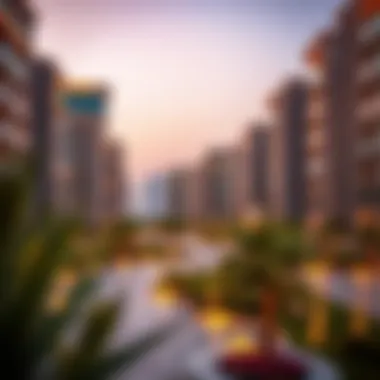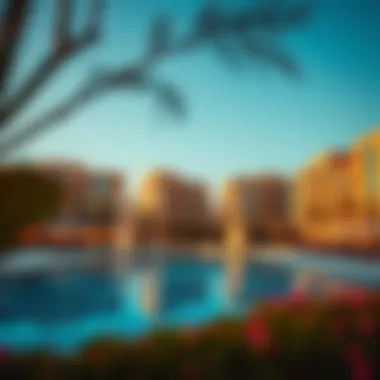Amber Real Estate Trends and Opportunities in Dubai


Intro
The amber real estate market in Dubai presents a unique blend of history, culture, and modern investment opportunities. As the city continues to evolve, the allure of amber properties has grown, making them a notable segment in the property landscape. Understanding this niche requires an exploration into its historical roots, architectural features, and current market performance, which can significantly inform potential investors and homeowners alike.
Dubai's amber real estate is more than just buildings; it's a reflection of a rich heritage mixed with contemporary designs. Each property carries stories of the past while embodying the vibrant spirit of the present. The insight into this market is invaluable for those looking to make informed decisions, whether they are seasoned investors or first-time buyers.
With a focus on market trends and investment strategies, we aim to provide a comprehensive overview of the amber real estate scene in Dubai, highlighting its significance in a rapidly changing property market.
Market Trends and Analysis
Recent Market Performance
The last few years have seen the amber real estate market in Dubai fluctuate, showing resilience amid global uncertainties. The rise in demand for unique, culturally infused properties has led to a steady increase in values. Amber properties often include bespoke architectural designs, which have become increasingly sought after in the luxury segment of the market.
Several luxury developments featuring amber aesthetics have launched successfully, leading to a surge in sales. Homebuyers are not just looking for a place to live; they are seeking experiences and cultural connections that amber properties provide.
Furthermore, properties like the Amber Tower and Amber Residences illustrate how developers have embraced this trend, blending modern living with traditional craftsmanship, catering to buyers' tastes.
Future Projections and Opportunities
Looking ahead, the amber real estate market holds considerable promise. The Dubai Expo 2020, while postponed due to the pandemic, is expected to drive tourism and foreign investment upon its commencement. As interest in Dubai continues to grow, investors eye properties that embody the city’s heritage, such as amber estates.
Moreover, urban regeneration projects in historical districts will likely increase the stock of amber real estate, presenting fresh opportunities. Investors and buyers who act early in securing these niche properties may see substantial returns in the coming years.
"Amber real estate in Dubai is not just about properties; it represents an investment in history and tradition, blending the old with the new."
Investment Strategies
Understanding Property Valuation
When considering amber properties, a thorough understanding of property valuation is crucial. Properties in this category are not merely assessed based on square footage and location. Instead, factors such as heritage significance, architectural style, and historical relevance play a significant role in determining value.
Investors must take into account recent sales of similar properties as well as the potential for future appreciation due to the unique charm these homes offer. Engaging with local real estate experts can provide insights that enhance understanding and decision-making in this specialized market.
Navigating Legal Considerations
Investing in amber real estate requires navigating a labyrinth of legal considerations, especially for foreign buyers. Regulatory frameworks in Dubai can be complex, with different laws applying to freehold and leasehold properties.
Familiarizing oneself with ownership rights, property registration procedures, and potential restrictions is essential. It’s advisable to consult with legal experts or real estate consultants who specialize in Dubai’s market to ensure compliance and streamline the purchasing process.
Understanding Amber Real Estate
The rise of amber real estate in Dubai suggests a shift in the property market, catering to unique tastes and preferences. This segment is not merely about aesthetic appeal but conveys a deeper appreciation for history, craftsmanship, and sustainability. Understanding amber real estate means recognizing how the material influences architectural styles, market dynamics, and ultimately, buyers’ decisions.
Defining Amber Real Estate
Amber real estate refers to properties that integrate amber, a fossilized tree resin, into their construction or design elements. It symbolizes luxury and nature harmoniously intertwined. This integration isn't just for show; it affects structural integrity and aesthetic value, making these properties stand out in Dubai's bustling market.
Historical Context of Amber in Architecture
Origins of Amber Usage
The usage of amber dates back thousands of years. Initially prized for its beauty, ancient civilizations, particularly those in the Baltic region, exploited amber for jewelry and talismans. The highlight of its charm lies in its warm hues and natural brilliance, which has always captivated human perception. Its incorporation into architecture gained traction, marking a significant pivot in using natural materials for both functional and decorative purposes. This trend has rippled through to modern-day Dubai, where builders harness this unique material, adding an intricate touch to buildings.


Cultural Significance of Amber Structures
Amber structures often carry profound cultural significance. In various traditions, amber is seen as a protector, thought to hold healing properties. By embedding amber into architectural frameworks, builders and designers can create environments that resonate with these deep-rooted cultural beliefs. For potential buyers or investors, this can translate to properties that not only serve as a dwelling but also embody stories and traditions that make them feel uniquely valuable.
Evolution of Amber Architecture
As time flows on, the architectural landscape has evolved dramatically with the use of amber. Initially seen in isolated projects, amber's use has expanded to more mainstream applications, praising its rustic charm alongside modern design sensibilities. New technologies have allowed for more innovative ways to integrate amber, leading to properties that serve not just as living spaces but as masterpieces that reflect a blend of old and new. This evolution is essential for understanding the amber real estate market in Dubai; it illustrates how traditional concepts can meet contemporary demands.
“Amber is not just a stone; it’s a story trapped in time, reflected in our walls.”
To sum up, understanding amber real estate goes beyond seeking immediate value in the market. It invites a deeper interaction with history, culture, and the unique characteristics that make these properties appealing. As Dubai’s market continues to evolve, the allure of amber provides a multifaceted perspective worth noting for any investor, developer, or homebuyer. For further insights, consider exploring Wikipedia, Britannica or Reddit.
Key Characteristics of Amber Properties
The realm of amber real estate is not just a niche but a vibrant segment that blends beauty and functionality remarkably. The characteristics of amber properties make them not only eye-catching but also appealing for potential investors and buyers rocketing through the Dubai property market. Let’s delve into the aesthetic and structural attributes that set these properties apart and explore their benefits.
Aesthetic Appeal
A property’s aesthetic appeal can make or break its allure in the competitive real estate landscape. In the case of amber properties, the visual characteristics are what tend to draw the attention of discerning buyers.
Color Variations
Color variations in amber are one of its most captivating features. Ranging from rich honey hues to deep golden tones, the color spectrum of amber never fails to impress. This diversity plays a crucial role in setting the ambiance of a property, allowing homeowners to evoke a sense of luxurious warmth. Such colors possess the unique ability to enhance natural light, making spaces feel inviting and energetic.
The dominant yellows and oranges of amber can also influence emotional well-being, presenting a cozy feel that no sterile white wall can replicate. This aspect alone can make amber properties a popular choice for buyers seeking comfort alongside visual appeal. However, choosing darker shades of amber can isoften add sophistication but may create a heavier atmosphere, which could be seen as disadvantageous depending on the intended use of the space.
Design Elements Incorporating Amber
The design elements that integrate amber into architectural creations can resonate strongly with cultural and aesthetic sentiments. From fixtures to flooring, these elements go beyond mere functionality, establishing a narrative within the spaces they occupy. For instance, amber pendant lights make a striking centerpiece, creating a contrast that plays beautifully against modern decor.
Using amber elements can invite a natural, cohesive feel into homes, paving the way to a seamless flow throughout the interiors. Such designs not only focus on beauty but can hold sentimental value as well, symbolizing longevity and ancient heritage. However, incorporating amber can sometimes drive up costs, making it a careful investment choice for budget-conscious developers.
Structural Integrity
While aesthetics capture attention, structural integrity ensures longevity, and this is an area where amber does not disappoint. When investing in amber properties, understanding the resilience they offer is vital.
Durability of Amber Materials
Amber materials are known for their surprising durability. Unlike many traditional materials that may degrade over time, amber stays remarkably intact when properly maintained. This characteristic heightens the appeal for those considering long-term investments.
Villas and homes made with amber materials bring the benefit of a timeless look and the promise of strength, making them favorable for both construction professionals and buyers alike. However, they are not invincible; improper maintenance can lead them vulnerable to cracking or discoloration under harsh conditions.
Comparison with Traditional Building Materials
When juxtaposed with traditional building materials, amber offers unique advantages. While concrete or steel can serve their purposes effectively, they come with their own set of challenges, such as environmental impact and aesthetic limitations. Amber, on the other hand, boasts a distinct character that can contribute positively to the surroundings.
Moreover, using amber allows for better insulation properties, which can lead to energy savings. Yet, the use of amber isn't without its flaws—sourcing and quality control can be tricky, leading to potential uncertainties in construction timelines.
The choice of materials can make a significant difference in both property value and buyer experience. Understanding those nuances is key in navigating the amber property market in Dubai.
In summation, the key characteristics of amber properties lay both a foundation for investment potential in Dubai’s dynamic market while illustrating the combination of beauty and practical benefits these stunning properties present.
Market Trends in Amber Real Estate
Understanding the market trends within amber real estate is essential for potential investors, homebuyers, and industry professionals. This segment of the real estate market is not just about unique properties but also reflects broader economic and cultural shifts. Recognizing current trends allows for informed investment decisions and highlights where the potential for growth lies.


Current Demand for Amber Properties
Factors Influencing Demand
The demand for amber properties in Dubai is shaped by several factors. One significant aspect is the increasing appreciation for unique architectural elements that differentiate amber properties from conventional designs. This growing demand is influenced by the luxurious lifestyle associated with amber, which attracts both local and international buyers.
Notably, the aesthetic qualities of amber, offering warm tones and exquisite designs, provide a unique selling point. This trend caters particularly to affluent buyers who seek not just homes but status symbols. As Dubai continues to establish itself as a global hub, the distinctiveness of amber properties adds to their allure. However, one must consider potential drawbacks, such as the limited availability of prime amber sites, which can make procurement difficult and expensive.
Profiles of Typical Buyers
Typical buyers in the amber real estate market profile a diverse group, often comprising high-net-worth individuals from various backgrounds. Many are attracted to Dubai's status as a luxury destination, looking to invest in property as both a residence and an asset.
The buyers often prioritize properties with rich historical contexts and unique architectural features. Their preference for amber reflects a desire not just for prestige but also for cultural authenticity. However, these buyers may also face challenges, such as navigating a competitive market where properties can go off the market quickly.
Investment Opportunities
Emerging Areas for Amber Development
Emerging areas for amber development are vital, showcasing potential for future growth. Regions such as Dubai Creek and Jumeirah have seen significant interest due to their strategic locations and cultural heritage. The charm of these neighborhoods often aligns with the rich characteristics of amber, making them prime targets for development.
Developers might explore underutilized lands in these regions, converting them into stunning amber complexes. However, prospective developers should be cautious of local regulations and zoning laws, which can complicate and delay projects.
Potential Returns on Investment
Potential returns on investment in amber properties are promising, particularly considering the growing status of Dubai as an international real estate haven. With increased demand and limited supply, properties featuring amber characteristics are likely to appreciate in value.
Strategically investing in amber real estate may lead to noteworthy profits, especially as the market matures. Nevertheless, one must weigh these prospects against the risks of market fluctuations and potential regulatory changes that could impact investment viability.
"Investors should be mindful of the complexity surrounding amber real estate while keeping a close eye on market dynamics to seize growth opportunities."
Navigating Regulatory Aspects
Understanding the regulatory landscape is vital when it comes to amber real estate in Dubai. The rules and guidelines not only provide a framework for development but also protect the interests of investors, developers, and the cultural heritage that amber structures symbolize. Having a firm grasp on the regulations assists stakeholders in making well-informed decisions and thereby minimizing risks entailed in property investments.
Legal Framework Governing Amber Properties
Permits and Approvals
The process of obtaining permits and approvals is a significant aspect of engaging with amber properties. Before any development or alterations can take place, developers must navigate this intricate process dictated by local authorities. A key characteristic of permits and approvals is their role in enforcing compliance with Dubai's zoning laws and safety standards.
This necessity comes with its share of advantages and disadvantages. On the one hand, stringent regulations can provide reassurance that properties are built to high standards. On the other hand, they can slow down project timelines, sometimes leading to increased costs. In particular, amber properties often require specialized considerations that add layers to the approval process, thus making it a complex but navigable maze that developers must traverse.
"Obtaining the proper permits is like having the right keys to unlock a treasure chest of opportunities, but if you're unprepared, it may just be a frustrating dead end."
Cultural Heritage Regulations
Cultural heritage regulations also play a pivotal role in shaping amber real estate in Dubai. These laws aim to preserve the historical and cultural essence associated with amber as a building material. The primary aspect of these regulations is their safeguard against the erasure of cultural significance as urban development advances.
One distinct feature of these regulations is their strict attention to the architectural styles that must be honored in new constructions or restorations. For property owners and developers, complying with these regulations fosters community ties and enhances the property’s value in a market that treasures uniqueness and history. However, while these regulations are beneficial for protecting heritage, their complexity and potential for delays can present challenges for developers looking to launch projects swiftly.
Challenges for Developers
Despite the protective nature of regulations, there are hurdles that developers encounter, particularly concerning costs and accessibility.


Compliance Costs
Compliance costs can significantly affect a developer's budget. These costs arise primarily from the need to hire professionals who ensure that designs meet the regulatory standards. Developers must either employ specialized consultants familiar with amber properties or adapt standard practices, leading to a rise in project expenses. While these costs might seem burdensome at first, they often yield benefits in the form of durable constructions that maintain their aesthetic appeal over time, making them a worthy investment.
Market Entry Barriers
In addition to compliance costs, market entry barriers pose another challenge for those interested in amber real estate. The strict regulations surrounding ownership and development can make it daunting for newcomers to break into the market. The time taken to navigate legal requirements often translates into lost opportunities, illustrating the unique pressures that amber developments face in comparison to traditional real estate investments. However, overcoming these barriers can lead to fruitful ventures that highlight the alluring qualities of amber properties, creating a niche market ripe for growth.
Understanding the complexity of regulations involved in amber real estate is key for anyone looking to invest, develop, or navigate the market in Dubai. Being well-acquainted with the legal frameworks can pave the way for making strategic decisions while enhancing the property's legacy in a rapidly evolving landscape.
Impact of Amber Properties on Dubai's Real Estate Market
The emergence of amber properties within Dubai’s vibrant real estate sector marks a significant shift in the landscape of property offerings available to investors, buyers, and developers. These distinctive properties not only go beyond conventional real estate but also actively contribute to the diversification of housing options, creating a more dynamic market environment. What makes amber properties striking is not just their unique aesthetic, but also their potential to attract a niche demographic seeking both beauty and investment potential.
Role in Diversifying Property Options
Comparative Analysis with Traditional Developments
When comparing amber properties with traditional developments, a few distinct characteristics come into play that highlight their unique appeal. Traditional buildings often rely on standard materials like concrete and glass, leading to homogeneous architecture across neighborhoods. On the other hand, amber properties stand out by incorporating this ancient material, allowing for exceptional designs that capture the essence of luxury and creativity.
One of the key advantages of amber properties is their ability to present diverse design possibilities. Each amber property often showcases a blend of modern functionality with historical significance. This affinity for unique architecture not only draws in potential buyers but also enhances the overall allure of developing areas in Dubai. In simpler terms, opting for amber structures can be a breath of fresh air in a market saturated with traditional designs, offering a competitive edge for property developers aiming to distinguish themselves.
Influence on Overall Market Dynamics
Amber properties affect the greater Dubai real estate market by introducing new dynamics into the buying and selling processes. For one, these unique properties can lead to increased competition among developers, encouraging them to innovate and improve their offerings. This competition is beneficial for buyers, as it could lead to higher standards and more options available.
Moreover, the influence of amber properties extends to pricing strategies. Homes crafted from amber can sometimes command higher prices due to their unique aesthetic and historical connotations, prompting an upswing in luxury real estate appeal. However, a notable disadvantage is that the specialized nature of these properties might limit the pool of potential buyers.
While it creates a niche market, potential investors must consider the target audience carefully. The rarity of amber-designed structures may translate into both opportunities and limitations, balancing market demand with the unique appeal that pitches amber real estate as a luxury segment.
Future Forecast
Predictions for Amber Market Growth
Looking ahead, the forecast for amber properties seems promising as global trends shift towards sustainability and unique living spaces. As buyers increasingly value distinctive architectural experiences over generic developments, the amber real estate segment could see significant growth. Developers who recognize this trend and invest accordingly are likely to reap the benefits of an expanding market.
Key factors contributing to the anticipated growth of amber properties include rising interest in sustainable building practices and an appreciation for local craftsmanship. Such properties may also benefit from potential partnerships with heritage conservation initiatives, adding further credibility and allure.
Potential Risks and Rewards
Nevertheless, investing in amber properties is not without its risks. A factor to consider is market volatility in luxury segments, where changes in economic conditions could impact buyer interest. Moreover, the challenge of sourcing authentic amber materials presents a unique hurdle, potentially driving costs up and affecting the profitability of developments.
However, if managed well, these risks may be outweighed by potential rewards. The combination of aesthetic value and cultural depth positions amber properties as premium offerings that can attract discerning buyers and investors alike. Keeping an eye on market trends and adapting to shifts in consumer preferences will determine the risk-reward balance in the years to come.
Ending
Summary of Key Insights
In summarizing the discussion, we find that amber real estate is characterized by:
- Historic Significance: Amber’s age-old presence in architecture reflects a depth that many contemporary materials cannot match.
- Aesthetic Appeal: The warm tones and unique textures of amber can transform spaces into visually stunning environments, attracting homeowners and renters alike.
- Market Trends: Current demand is shaped by factors such as cultural appreciation and the wish for distinctiveness in residential choices. This scenario offers fruitful investment opportunities, particularly in areas witnessing developmental growth.
- Regulatory Framework: Navigating the legal landscape regarding amber properties is essential, highlighting the importance of compliance with cultural heritage regulations and securing necessary permits.
- Market Dynamics: The positioning of amber real estate as a differentiated offering can significantly influence the overall property market in Dubai, paving the way for new standards in luxury living.
Final Thoughts on Amber Real Estate
Reflecting on the amber real estate scene, it becomes clear that investing in these properties is not just about the present but also about long-term value appreciation. The appeal of amber structures lies not only in their aesthetic and structural qualities but also in their potential to become cultural landmarks within the urban fabric of Dubai.
For investors and developers, keeping a finger on the pulse of market trends will prove vital in making informed decisions. Moreover, buyers looking for uniqueness will find that amber properties not only meet but often exceed their expectations, melding tradition with modernity. Ultimately, as the market continues to evolve, the prospects for amber real estate seem promising, making it a space worth watching closely.
"Investing in amber properties isn't merely a transaction; it's a commitment to preserving culture while embracing modern luxury."
For further reading on Dubai's architecture and its real estate trends, you may consult resources like Britannica and Wikipedia.











